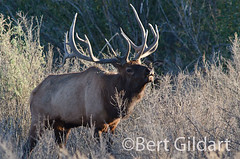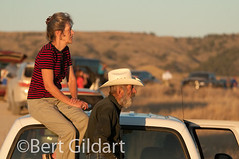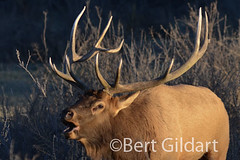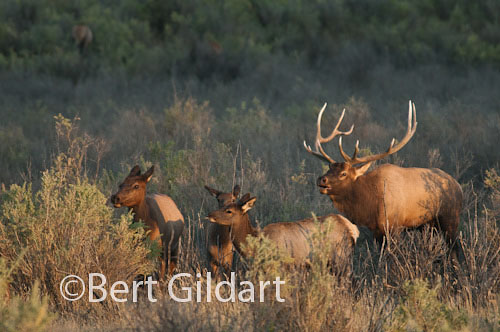C M Russell Wildlife Refuge Provides Elk With Magnificent Stage
 ©Bert Gildart: I am a few days behind in the dates ascribed to my posts, essentially because we have based ourselves in areas that have no connections, specifically Zortman, Montana. The settlement is located in the Little Rockies and for this posting it must be noted that we are but a 40 minute drive from one of the nation’s greatest wildlife spectacles - the fall rut of elk, which here includes literally hundreds of these magnificent creatures.
©Bert Gildart: I am a few days behind in the dates ascribed to my posts, essentially because we have based ourselves in areas that have no connections, specifically Zortman, Montana. The settlement is located in the Little Rockies and for this posting it must be noted that we are but a 40 minute drive from one of the nation’s greatest wildlife spectacles - the fall rut of elk, which here includes literally hundreds of these magnificent creatures.
The stage is the Charles M. Russell Wildlife Refuge, specifically the Slippery Ann Wildlife Viewing area, which is immediately adjacent to where Adam, Sue, Janie and I took out from our seven-day float on the Missouri River one month ago.
It is here that Janie and I watched two nights ago as an estimated 300 elk materialized from stands of cottonwood trees, and then edged closer and closer until it seemed as though we had front seats at what could be the photo opportunity of a lifetime.
PERFORMANCE WILL BLOW YOUR MIND
The performance began about 5:30 p.m. but before you could see the elk, you could hear them and their famous bugling. Bull elk create the music and do so by tilting back their heads and emitting a sound that begins on a low note then progresses up the scale. Finally, it ends with a guttural “Ugh, ugh.” Hearing them is one thing, but when you hear not just one bull creating the sound but dozens, it blows your mind.
The purpose of the bugling – followed by aggressive gestures in which they use their antlers to blow up the dirt, “murder” small trees, or actually engage other bulls in battle – is intended to help each bull establish a territory.
L to R: Bull elk establish a harem and warn other males to keep out by bugling, fighting and tearing up the ground; CMR attracts thousands annually, often to watch elk; six-point or “Royal” elk.
Here, in a space each bull must mentally define, he guards his developing harem, and woe be to any interloper, particularly to “the welterweights,” or to one whose spread of antlers is inferior – that enters this space. Presumably the genetically superior bull emerges victorious and it is he that passes on his genes.
CMR IS MAGNIFICENT STAGE
We watched the display for about three hours and saw bulls whose antlers were represented by all the various descriptive nomenclature. Biologists have created a system of classification. Bulls with six tines (most typically) are categorized as a Royal while those with seven or eight are categorized as an Imperial and Monarch, respectively. We saw them all, and most importantly from my perspective, I was able to photograph them all. To obtain frame filling images I used lens ranging from 400 to 800mm.
Dramas such as this should be set on a stage of magnificence, and the CMR qualifies. Encompassing about 1,100,000 acres, the Charles M. Russell National Wildlife Refuge extends 125 miles east/west. Lewis and Clark saw it first and described the area in glowing terms. The refuge was set aside in 1936 by President Roosevelt and, today, some call it the crown jewel of the National Wildlife Refuge system.
They’ll get no arguments from us.
—————————-
THIS TIME FIVE YEARS AGO:
4th ed. Autographed by the Authors
Hiking Shenandoah National Park
 Hiking Shenandoah National Park is the 4th edition of a favorite guide book, created by Bert & Janie, a professional husband-wife journalism team. Lots of updates including more waterfall trails, updated descriptions of confusing trail junctions, and new color photographs. New text describes more of the park’s compelling natural history. Often the descriptions are personal as the Gildarts have hiked virtually every single park trail, sometimes repeatedly.
Hiking Shenandoah National Park is the 4th edition of a favorite guide book, created by Bert & Janie, a professional husband-wife journalism team. Lots of updates including more waterfall trails, updated descriptions of confusing trail junctions, and new color photographs. New text describes more of the park’s compelling natural history. Often the descriptions are personal as the Gildarts have hiked virtually every single park trail, sometimes repeatedly.
Big Sky Country is beautiful
Montana Icons: 50 Classic Symbols of the Treasure State
![]() Montana Icons is a book for lovers of the western vista. Features photographs of fifty famous landmarks from what many call the “Last Best Place.” The book will make you feel homesick for Montana even if you already live here. Bert Gildart’s varied careers in Montana (Bus driver on an Indian reservation, a teacher, backcountry ranger, as well as a newspaper reporter, and photographer) have given him a special view of Montana, which he shares in this book. Share the view; click here.
Montana Icons is a book for lovers of the western vista. Features photographs of fifty famous landmarks from what many call the “Last Best Place.” The book will make you feel homesick for Montana even if you already live here. Bert Gildart’s varied careers in Montana (Bus driver on an Indian reservation, a teacher, backcountry ranger, as well as a newspaper reporter, and photographer) have given him a special view of Montana, which he shares in this book. Share the view; click here.
$16.95 + Autographed Copy
What makes Glacier, Glacier?
Glacier Icons: 50 Classic Views of the Crown of the Continent
![]() Glacier Icons: What makes Glacier Park so special? In this book you can discover the story behind fifty of this park’s most amazing features. With this entertaining collection of photos, anecdotes and little known facts, Bert Gildart will be your backcountry guide. A former Glacier backcountry ranger turned writer/photographer, his hundreds of stories and images have appeared in literally dozens of periodicals including Time/Life, Smithsonian, and Field & Stream. Take a look at Glacier Icons
Glacier Icons: What makes Glacier Park so special? In this book you can discover the story behind fifty of this park’s most amazing features. With this entertaining collection of photos, anecdotes and little known facts, Bert Gildart will be your backcountry guide. A former Glacier backcountry ranger turned writer/photographer, his hundreds of stories and images have appeared in literally dozens of periodicals including Time/Life, Smithsonian, and Field & Stream. Take a look at Glacier Icons
$16.95 + Autographed Copy






October 1st, 2011 at 7:01 am
Great place in our travel book. Sandi and I were there last year this time following the Lewis & Clark trail and enjoyed seeing the rut again. I interrupted a large wolf encounter with a free-range cow calf on our first visit ten years ago. Only thing missing from the L&C days are grizzlies. Still plenty of rattlers tho!
Zortman is a funky little town with interesting history. Part of the old Outlaw Trail if I remember correctly!
October 3rd, 2011 at 11:14 am
Hi Bert,
If you are still interested in elk on the CMR Refuge, you might want to talk with the folks at http://www.landwehroutfitters.com. They’ve been guiding hunters on the refuge for a long time…might have some interesting stories for you, or some interesting locations to tell you about. They are clients of mine.
Oh, and I’m pretty sure Lewis and Clark were not the first to see the refuge (grin).
September 17th, 2012 at 5:12 am
[...] *CMR Host Annual Elk Spectacle [...]